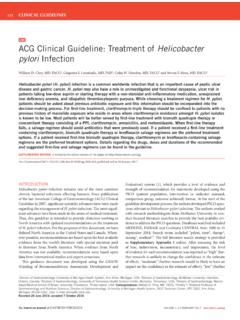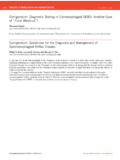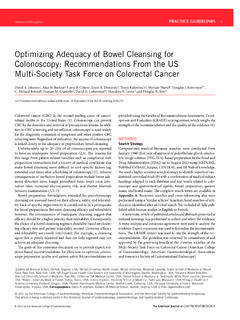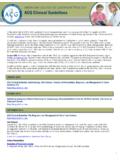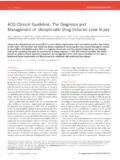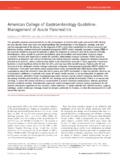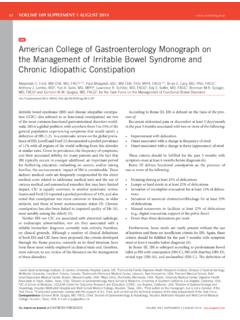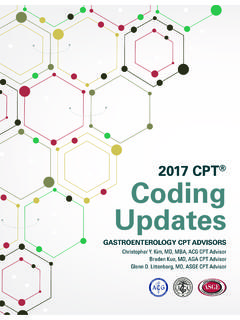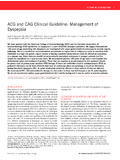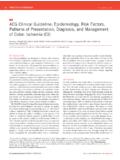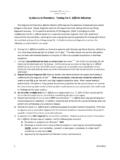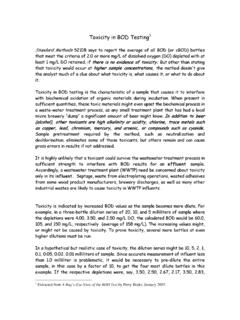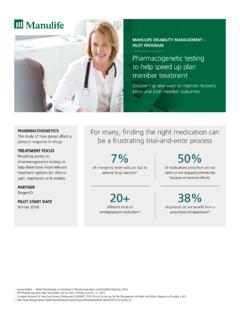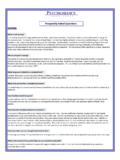Transcription of Guidelines for Diagnosis, Treatment, and Prevention of ...
1 478 PRACTICE Guidelines nature publishing group CME. Guidelines for diagnosis , treatment , and Prevention of Clostridium difficile Infections Christina M. Surawicz, MD1, Lawrence J. Brandt, MD2, David G. Binion, MD3, Ashwin N. Ananthakrishnan, MD, MPH4, Scott R. Curry, MD5, Peter H. Gilligan, PhD6, Lynne V. McFarland, PhD7,8, Mark Mellow, MD9 and Brian S. Zuckerbraun, MD10. Clostridium difficile infection (CDI) is a leading cause of hospital-associated gastrointestinal illness and places a high burden on our health-care system. Patients with CDI typically have extended lengths-of-stay in hospitals, and CDI is a frequent cause of large hospital outbreaks of disease. This guideline provides recommendations for the diagnosis and management of patients with CDI as well as for the Prevention and control of outbreaks while supplementing previously published Guidelines . New molecular diagnostic stool tests will likely replace current enzyme immunoassay tests.
2 We suggest treatment of patients be stratified depending on whether they have mild-to-moderate, severe, or complicated disease. Therapy with metronidazole remains the choice for mild- to-moderate disease but may not be adequate for patients with severe or complicated disease. We propose a classification of disease severity to guide therapy that is useful for clinicians. We review current treatment options for patients with recurrent CDI and recommendations for the control and Prevention of outbreaks of CDI. Am J Gastroenterol 2013; 108:478 498; ; published online 26 February 2013. INTRODUCTION change the estimate; and low , if further research is very likely to Clostridium difficile infection (CDI) is a leading cause of hospital- change the estimate. associated gastrointestinal illness and places a high burden on our health-care system, with costs of billion dollars annually (1,2). This guideline provides recommendations for the diagnosis and EPIDEMIOLOGY AND RISK FACTORS.
3 Management of patients with CDI as well as for the Prevention Clostridium difficile (C. difficile) is a Gram-positive, spore- and control of outbreaks. It supplements previously published forming bacterium usually spread by the fecal-oral route. It is Infectious Disease Society of America (IDSA)/Society of Hospital non-invasive and produces toxins A and B that cause disease, Epidemiologists of America (SHEA) and European Society of ranging from asymptomatic carriage, to mild diarrhea, to Clinical Microbiology and Infectious Diseases (ESCMID) guide- colitis, or pseudomembranous colitis. CDI is defined as the lines (3,4) and an evidence-based review (5). acute onset of diarrhea with documented toxigenic C. difficile or Each section presents the key recommendations followed by a its toxin and no other documented cause for diarrhea (3). summary of the evidence (Table 1). The GRADE system was used Rates of CDI have been increasing since 2000, especially in the to grade the strength of our recommendations and the quality of elderly with a recent hospitalization or residing in long-term care the evidence (6).
4 The strength of a recommendation is graded as facility (LTCF). Carriage of C. difficile occurs in 5 15% of healthy strong , when the evidence shows the benefit of the intervention adults, but may be as high as in newborns and healthy infants, or treatment clearly outweighs any risk, and as conditional , when and up to 57% in residents in LTCF. Transmission in health-care uncertainty exists about the risk benefit ratio. The quality of the facilities results mostly from environmental surface contamination evidence is graded as follows: high , if further research is unlikely and hand carriage by staff members and infected patients. to change our confidence in the estimate of the effect; moderate , The two biggest risk factors are exposure to antibiotics if further research is likely to have an important impact and may and exposure to the organism; others are comorbid conditions, 1. Division of Gastroenterology, Department of Medicine, University of Washington School of Medicine, Seattle, Washington, USA; 2 Albert Einstein College of Medicine, Emeritus Chief, Division of Gastroenterology, Montefiore Medical Center, Bronx, New York, USA; 3 Division of Gastroenterology, Hepatology and Nutrition, Department of Medicine, University of Pittsburgh, Pittsburgh, Pennsylvania, USA; 4 Gastrointestinal Unit, Massachusetts General Hospital and Harvard Medical School, Boston, Massachusetts, USA; 5 Division of Infectious Diseases, Department of Medicine, University of Pittsburgh, Pittsburgh, Pennsylvania, USA; 6 Clinical Microbiology- Immunology Laboratories, University of North Carolina Hospitals, Chapel Hill, North Carolina, USA; 7 Health Services Research and Development, Department of Veterans Affairs, VA Puget Sound Health Care System, Seattle, Washington, USA.
5 8 Department of Medicinal Chemistry, School of Public Health, University of Washington, Seattle, Washington, USA; 9 Digestive Health Center, INTEGRIS Baptist Medical Center, Oklahoma City, Oklahoma, USA; 10 Department of Surgery, University of Pittsburgh and VA Pittsburgh Healthcare System, Pittsburgh, Pennsylvania, USA. Correspondence: Christina M. Surawicz, MD, Division of Gastroenterology, Department of Medicine, University of Washington School of Medicine, 325 Ninth Avenue, Seattle, Washington 98104, USA. E-mail: Received 12 August 2012; accepted 18 December 2012. The American Journal of GASTROENTEROLOGY VOLUME 108 | APRIL 2013 Guidelines for CDI 479. Table 1. Summary and strength of recommendations Diagnostic tests 1. Only stools from patients with diarrhea should be tested for Clostridium difficile. (Strong recommendation, high-quality evidence). 2. Nucleic acid amplification tests (NAAT) for C.
6 Difficile toxin genes such as PCR are superior to toxins A + B EIA testing as a standard diagnostic test for CDI. (Strong recommendation, moderate-quality evidence). 3. Glutamate dehydrogenase (GDH) screening tests for C difficile can be used in two- or three-step screening algorithms with subsequent toxin A and B EIA. testing, but the sensitivity of such strategies is lower than NAATs. (Strong recommendation, moderate-quality evidence). 4. Repeat testing should be discouraged. (Strong recommendation, moderate-quality evidence). 5. Testing for cure should not be done. (Strong recommendation, moderate-quality evidence). Management of mild, moderate, and severe CDI. 6. If a patient has strong a pre-test suspicion for CDI, empiric therapy for CDI should be considered regardless of the laboratory testing result, as the negative predictive values for CDI are insufficiently high to exclude disease in these patients.
7 (Strong recommendation, moderate-quality evidence). 7. Any inciting antimicrobial agent(s) should be discontinued, if possible. (Strong recommendation, high-quality evidence). 8. Patients with mild-to-moderate CDI should be treated with metronidazole 500 mg orally three times per day for 10 days. (Strong recommendation, high-quality evidence). 9. Patients with severe CDI should be treated with vancomycin 125 mg four times daily for 10 days (Conditional recommendation, moderate-quality evidence). 10. Failure to respond to metronidazole therapy within 5 7 days should prompt consideration of a change in therapy to vancomycin at standard dosing. (Strong recommendation, moderate-quality evidence). 11. For mild-to-moderate CDI in patients who are intolerant/allergic to metronidazole and for pregnant/breastfeeding women, vancomycin should be used at standard dosing. (Strong recommendation, high-quality evidence).
8 12. In patients in whom oral antibiotics cannot reach a segment of the colon, such as with Hartman's pouch, ileostomy, or colon diversion, vancomycin therapy delivered via enema should be added to treatments above until the patient improves. (Conditional recommendation, low-quality evidence). 13. The use of anti-peristaltic agents to control diarrhea from confirmed or suspected CDI should be limited or avoided, as they may obscure symptoms and precipitate complicated disease. Use of anti-peristaltic agents in the setting of CDI must always be accompanied by medical therapy for CDI. (Strong recommendation, low-quality evidence). Management of severe and complicated CDI. 14. Supportive care should be delivered to all patients and includes intravenous fluid resuscitation, electrolyte replacement, and pharmacological venous thromboembolism prophylaxis. Furthermore, in the absence of ileus or significant abdominal distention, oral or enteral feeding should be continued.
9 (Conditional recommendation, low-quality evidence). 15. CT scanning of the abdomen and pelvis is recommended in patients with complicated CDI. (Conditional recommendation, low-quality evidence). 16. Vancomycin delivered orally (125 mg four times per day) plus intravenous metronidazole (500 mg three times a day) is the treatment of choice in patients with severe and complicated CDI who have no significant abdominal distention. (Strong recommendation, low-quality evidence). 17. Vancomycin delivered orally (500 mg four times per day) and per rectum (500 mg in a volume of 500 ml four times a day) plus intravenous metronidazole (500 mg three times a day) is the treatment of choice for patients with complicated CDI with ileus or toxic colon and/or significant abdominal distention. (Strong recommendation, low-quality evidence). 18. Surgical consult should be obtained in all patients with complicated CDI.
10 Surgical therapy should be considered in patients with any one of the following attributed to CDI: hypotension requiring vasopressor therapy; clinical signs of sepsis and organ dysfunction (renal and pulmonary); mental status changes; white blood cell count 50,000 cells/ l, lactate 5 mmol/l; or failure to improve on medical therapy after 5 days. (Strong recommenda- tion, moderate-quality evidence). Management of recurrent CDI (RCDI). 19. The first recurrence of CDI can be treated with the same regimen that was used for the initial episode. If severe, however vancomycin should be used. The second recurrence should be treated with a pulsed vancomycin regimen. (Conditional recommendation, low-quality evidence). 20. If there is a third recurrence after a pulsed vancomycin regimen, fecal microbiota transplant (FMT) should be considered. (Conditional recommendation, moderate-quality evidence). 21. There is limited evidence for the use of adjunct probiotics to decrease recurrences in patients with RCDI.
